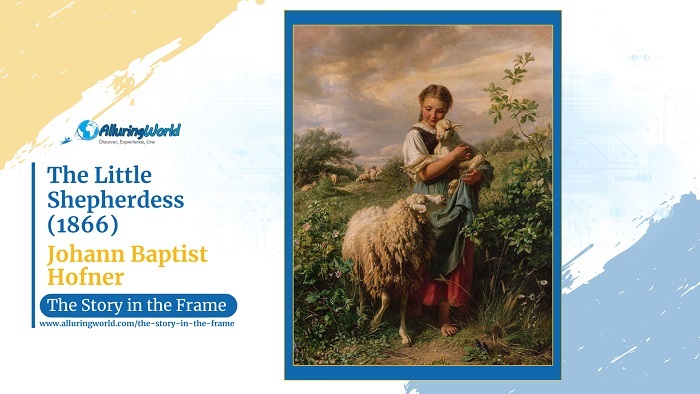Painted in the 19th century, more precisely in 1866, The Little Shepherdess is a charming and tender depiction of rural life by Johann Baptist Hofner, a German artist known for his pastoral scenes. The painting captures the innocence and simplicity of childhood against the backdrop of a serene countryside, portraying a young girl tending to her flock. Hofner’s work reflects the romanticized view of rural existence that was popular during his time, celebrating nature and traditional agrarian life with remarkable detail and warmth.
About the Painter:
Johann Baptist Hofner (1832–1913) was a German painter who was renowned for his idyllic images of peasants and livestock. He was a member of the Munich School and was involved in the field of genre painting, focusing on the balance of human existence with nature. Shepherds, farmers, and animals feature in much of his work, demanding a peaceful coexistence and a romantic appreciation of peasant ways. Hofner’s meticulous attention and tact in capturing emotions by soft lighting and realistic representations led to his work being highly acclaimed.
Inspiration and Reasons Behind the Painting:
During the 19th century, there was a growing romantic fascination with rural life, particularly in contrast to the rapid industrialization of cities. Hofner, like many of his contemporaries, sought to capture the purity and tranquility of the countryside, emphasizing the virtues of simplicity and hard work, and the The Little Shepherdess aligns with this theme, presenting an image of youthful innocence and quiet devotion to nature. The painting likely served as both a nostalgic reflection of pastoral traditions and a subtle commentary on the importance of preserving a connection to the land.
What is Depicted in the Painting:
The painting portrays a young shepherdess, likely no older than ten, seated on a grassy patch as she watches over her sheep. She wears a simple, rustic dress with a headscarf, reinforcing her humble origins, and her gaze is soft and contemplative, suggesting a quiet connection to her surroundings. The flock that is painted with lifelike precision, grazes peacefully nearby, reinforcing the sense of harmony between human and animal, and the rolling hills and soft, golden light suggest either early morning or late afternoon, adding a poetic touch to the composition.
Colors and Techniques:
Hofner’s color palette in The Little Shepherdess is warm and earthy, with soft greens, browns, and golden yellows dominating the scene. His use of natural lighting enhances the pastoral setting, casting a gentle glow over the young girl and her flock. The brushwork is finely detailed, particularly in the rendering of the animals and the folds of the girl’s clothing, showcasing Hofner’s skill in realism. The landscape is painted with a delicate softness, ensuring that the focus remains on the shepherdess while still creating a lush and inviting environment.
Conclusion:
In conclusion, The Little Shepherdess remains a touching tribute to rural life, embodying the ideals of innocence, simplicity, and a harmonious relationship with nature. Hofner’s ability to capture both the beauty of the landscape and the tender expression of the young girl makes this painting a timeless celebration of pastoral traditions, and today, it continues to evoke a sense of nostalgia for a way of life that, while fading in modern society, remains deeply valued in art and culture.

